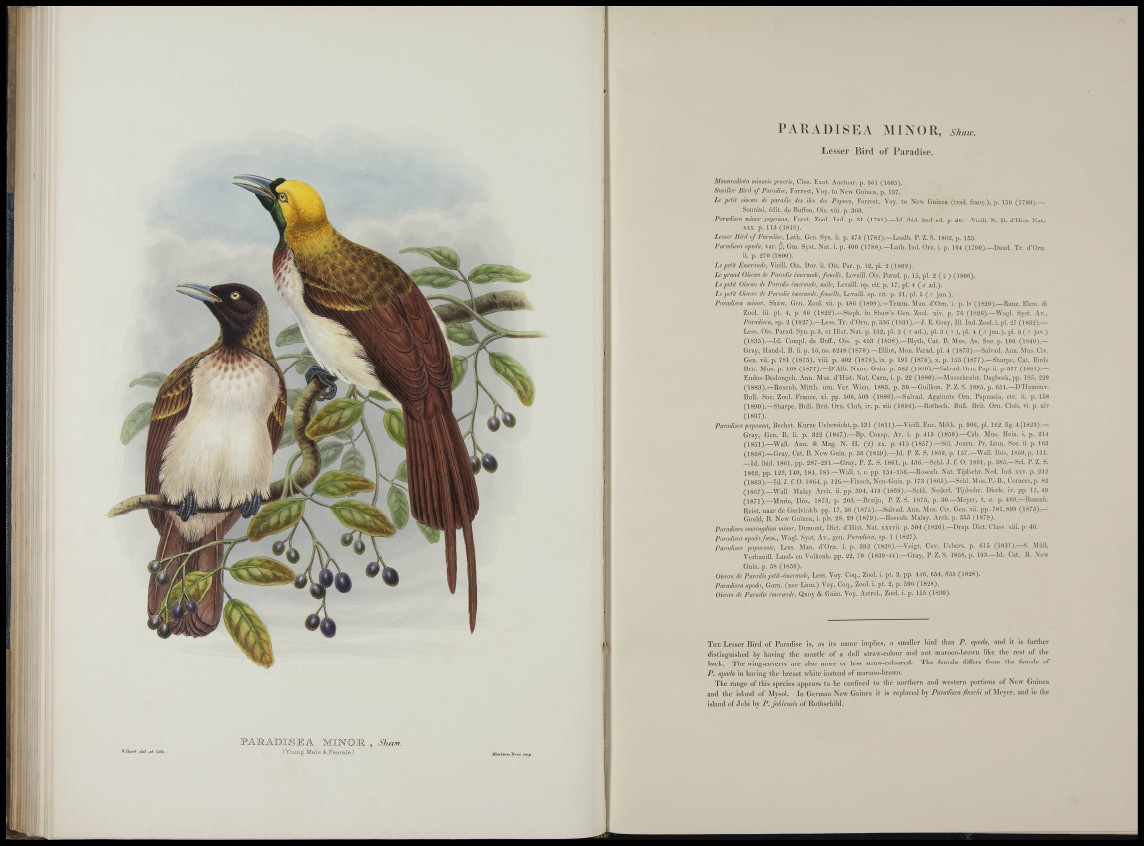
- I
¡1
1«:
P A M A B I S E A
(Young Male Scremale.)
Sham.
Mint^mlirvs. itnfi
PARADISEA MINOR,
Lesser Bird of Piiradise.
Mmmcodiata minoris generis, Clus. Exot. Auctuar. p. 3ül (UiOj).
Smaller Bird of Paradise, Forrest, Voy. to New Guinea, p. i;i7.
Le peta oiseau de paradis des iles des Papous, Forrest, Voy. to New Guinea (trad, frani;.), p. 150 (17SÜJ.—
Soiinini, edit, de Buffon, Ois. viii. p. 360.
Paradisea minor papuana, Forst. Zool. Ind. p. 31 (1781).—Id. ibid. 2nd ed. p. 20.—Vieiil. N. D. d'llist. Nat.
XXX. p. 113 (1819).
Lesser Bird of Paradise, Lat.li. Gen. Syn. ii. p. 474 (1782).—Leadb. P. Z. S. 18(;2, p. 153.
Paradisea apoda, var. ¡i. Gm. Syst. Nat. i. p. 400 (17S8).—Lath. Ind. Orn. i. p. 194 (1790).—Daud. Tr. d'Orn.
ii. p. 270 (1800).
Le petit Émeraude, Vieil]. Ois. Dor. ii. Ois. Par. p. 13, pi. 2 (1802).
Le ¡rand Oiseau de Paradis émeraude, femelle, Lefaill. Ois. Parad, p, 15, pl. 2 ( $ ) (180(>).
Le petit Oiseau de Paradis émeraude, mide, Levaiil. op. cit. p. 17, pl. 4 ( d ad.).
Le petit Oiseml de Paradis émeraude, femelle, Levaiil. op. cit. p. 21, pl. 5 (tî jun.).
Paradisea minor, Shaw, Gen. Zool. vii. p. 48(i (180!)).—Temm. Man. d'Orn. i. p. Iv (1820).—Ranz. Eiern, di
Zool. iii. pt. 4, p. Oe (1822).—Steph. in Sliaw's Gen. Zool. xiï. ¡). 7(ì (1820).—Wagl. Syst. Av.,
Paradisea, sp. 2 (1827).—Less. Tr. d'Orn. p. 336 (1831).—J. E. Gray, 111. Ind. Zool. i. pl. 27 (1832).—
Less. Ois. Parad. Syn. p. 3, et Hist. Nat. p. 132, pl. 2 ( ä ad.), pl. 3 ( ï ), pl. 4 ( c( jun. ) , pl. 0 ( s juv.)
(1835).—Id. Compi, de Buff., Ois. p. 453 (1838).—Blyth, Cat. B. Mus. As. Soc. p. 10« (1849).—
Gray, Hand-I. B. ii. p. 16,no. 0248 (1870).—Elliot, Mon. Parad, pl. 4 (1873).—Salvad. Ann. Mus. Civ.
Gen. vii. p. 781 (1875), viii. p. 402 (1876), ix. p. 191 (1870), x. p. 153 (1877).—Sharpe, Cat. Birds
Brit. Mus. p. 168 (1877).—D'Alb. Nuov. Guin. p. 582 (1880).—Salvad. Oni. Pap. ii. p. 577 (1881).—
Eudes-Deslongch, Ann. Mus. d'llist. Nat. Caen, i. p. 22 (1880).—Musschenbr. Dagboek,pp. 18.5, 220
(1883).—Rosenb. Mitth. orn. Ver. Wien, 1885, p. 30.—Guillem. P. Z. S. 1885, p. 651.—D'llamonv.
Bull. Soc. Zool. France, xi. pp. 500, 509 (1886).—Salvad. Aggiunte Orn. Papuasia, etc. ii. p. 158
(1890).—Sharpe, Bull. Brit. Orn. Club, iv. p. xiii (1894).—Rothsch. Bull. Brit. Orn. Club, vi. p. xlv
(1897).
Paradisea papuana. Sechst. Kurze Uebersicht, p. 131 (1811).—Vieill. Ene. Méth. p. 900, pl. H2. fig. 4 (1823).—
Gray, Gen. B. ii. p. 322 (1847).—Bp. Consp. Av. i. p. 413 (1850).—Cab. Mus. Hein. i. p. 214
( 1 8 5 1 ) . _ W a l l . Ami. & Mag. N. H. (2) xx. p. 415 (1857).—Sel. Journ. Pr. Lhm. Soc. ii. p. 103
(1858).—Gray, Cat. B. New Guin. p. 30 (1859).—Id. P. Z. S. 1859, p. 157.—Wall. Ibis, 1859, p. 111.
—Id. ibid. 1861, pp. 287-291.—Gray, P. Z. S. 1801, p. 430.—Sehl. J. f. O. 1801, p. 385.—.Sel. P. Z. S.
1862, pp. 123, 140, 184, 185.—Wall. t. c. pp. 154-150.—Rosenb. Nat. ïijdschr. Ned. Ind. xxv. p. 242
0 8 ( ; 3 ) , _ I c l . ,1, f. 0 . 1804, p. 120.—Finsch, Neu-Guin. p. 173 (1865).—Sehl. Mus. P.-B., Coraces.p. 82
(1807).—Wall. Malay Areh. ii. pp. 394, 41!) (1809).—Sehl. Nederi. Tijdschr. Dierk. iv. pp. 17,49
(1871).—Mûrie, Ibis, 1873, p. 203.—Bruijn, P. Z. S. 1875, p. 30.—Meyer, t. c. p. 409.—Rosenb.
Reist, naar de Geelvinkb. pp. 17, 56 (1875).—Salvad. Ann. Mus. Civ. Gen. vii. pp. 781,899 (1875).—
Gould, B. New Guinea, i. pis. 28, 29 (1879).—Rosenb. Malay. Arch. p. 555 (1879).
Paradisea smaragdina minor, Dumont, Diet, d'llist. Nat. xxxvii. p. 504 (1826).—Drap. Diet. Class, xiii. p. 46.
Paradisea apoda foem., Wagl. Syst. Av., gen. Paradisea, sp. 1 (1827).
Paradisea papìtensis, Less. Man. d'Orn. i. p. 392 (1828).—Voigt, Cuv. Uebers. p. 615 (1831).—S. Müll.
Verhandl. Land- en Volkenk. pp. 22, 70 (1839-44).—Gray, P. Z. S. 1858, p. 193.—Id. Cat. B. New
Guin. p. 58 (1859).
Oiseau de Paradispetit-émeramle. Less. Voy. Coq., Zool. i. pt. 2, pp. 440, 054, 055 (1828).
Paradisea apoda, Garn, (nec Linn.) Voy. Coq., Zool. i. pt. 2, p. 590 (1828).
Oiseau de Paradis émeraude, Quoy & Gaim. Voy. Astrol., Zool. i. p. 155 (1830).
T h e Lesser Bird of Paradise is, as its name implies, a smaller bird than P. apoda, and it is further
dislingnislied by having the mantle of a dull straw-colour and not maroon-brown like the rest of tlje
back. The n-ing-coverts are also more or less straw-coloured. The female differs from the female of
P. apoda in having the breast white instead of maroon-brown.
The range of this species appears to be confined to the northern and western portions of New Guinea
and the island of Mysol. In German New Guinea it is replaced by Paradiseu finsohi of Meyer, and in the
i.sland of Jobi by P.johknsh of Kothschild.